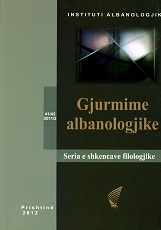HARMONIZIMI I NDRYSHORËVE DIATOPIKË DHE DIASTRATIKË SI GUR THEMELI TË JETËSISË LIGJËRIMORE
HARMONIZATION OF DIATOPIC AND DIASTRATIC VARIATIONS AS FOUNDATIONS OF DISCURSIVE IMPLEMENTATION
Author(s): Gjovalin ShkurtajSubject(s): Language and Literature Studies
Published by: Instituti Albanologjik i Prishtinës
Keywords: HARMONIZATION OF DIATOPIC ; DIASTRATIC VARIATIONS ; FOUNDATIONS OF DISCURSIVE IMPLEMENTATION
Summary/Abstract: Dialect is a foundation of standard discourse building and general linguistic development of any person. Dialect compared to standard language which is built upon them, are like large unhewn stones that are put in the foundation of high modern and magnificent buildings. Foundation stones are down and deep in the earth and are invisible but in fact they hold on them a building no matter how magnificent and glassy it is. Same happens with the written language which is build upon dialects and, with time, they will not bee seen or can be seen just a bit. This present day notion, of course, can’t be observed aside from teachings and experience of past generations and ancestors, from whom remained a smart postulate that language is connected to the thought as spirit is to the body, that the word is in the same relation to the ideas as is the core with the performance and that, therefore, word is a clothe, a robe, a form, an expression of human thoughts, certainly also a mirror of his ethno cultural, educational and conceptual development and constitution. Dialects of Albanian language are very close to each other, both when faced on the fact of being two biggest ramifications: Gheg -Tosk, but also when faced lower as facing of subsystems and sub-ramifications or sub-dialects and speech groups which can be identified in each of two Albanian dialects. The idea of borders, especially “clear-cut” or “absolute” borders between two Albanian dialects has lead sometimes to wrong estimations, especially those who required to see not two dialectical ramifications of the same language, but two different “idioms”, even two different languages.
Journal: Gjurmime Albanologjike - Seria e shkencave filologjike
- Issue Year: 2011
- Issue No: 41-42
- Page Range: 095-106
- Page Count: 12
- Language: Albanian
- Content File-PDF

